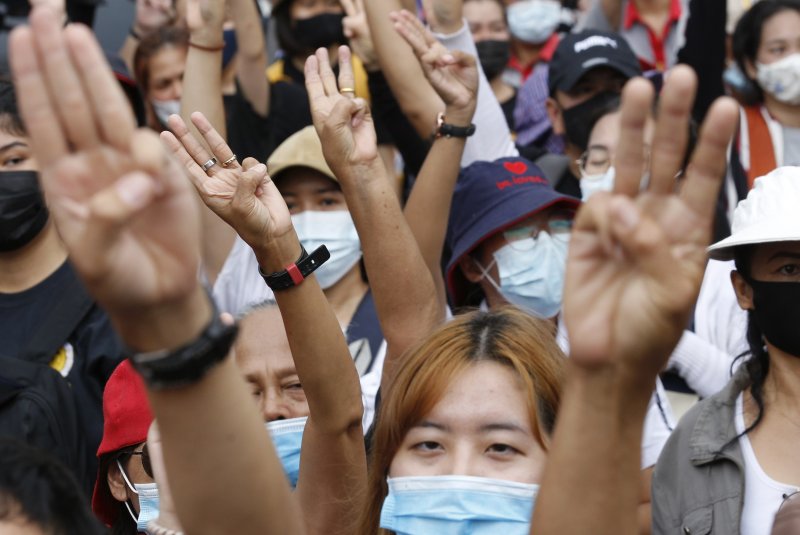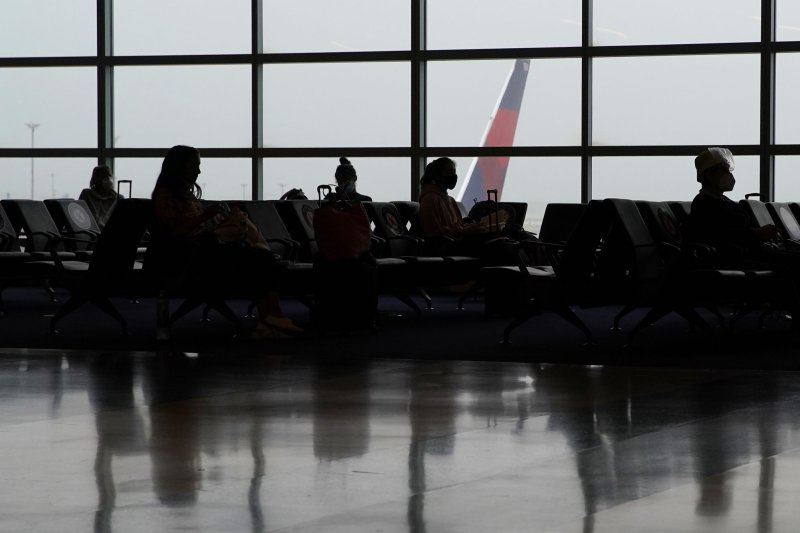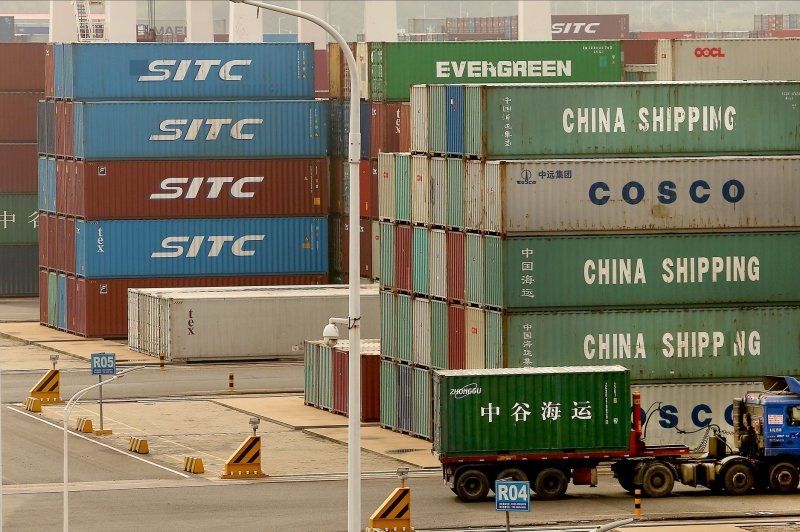Uber And Lyft Spent Hundreds Of Millions To Win Their Fight Over Workers’ Rights. It Worked.
At the start of the year, it looked like the labor movement was gaining ground in its fight for gig workers’ rights. The tech industry spent big to defeat them.
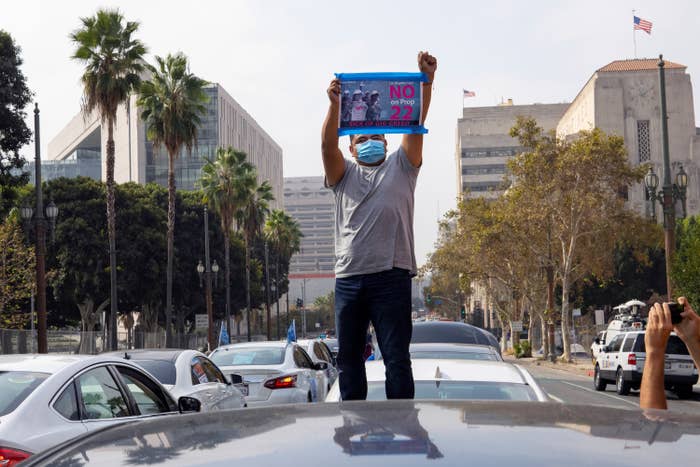
A demonstration in Los Angeles to urge people to vote no on Proposition 22.
At the start of 2020, organized labor had a lot to celebrate.
The workers’ rights advocates who for years had warned of the potentially devastating impact of the growing gig economy had succeeded in getting California to pass landmark legislation that would defend basic labor rights for hundreds of thousands of people.
At the time, the coronavirus pandemic — which would crater the economy and wipe out millions of jobs — wasn’t even a consideration; for unions, things were looking up.
The passing of the law, called AB5, in September 2019 officially made drivers for Uber, Lyft, Postmates, DoorDash, and Instacart employees in California, securing them benefits like a legal minimum wage and paid sick days. It was a huge victory over the tech industry, which had fought vociferously to define gig workers as considerably cheaper independent contractors. But by February of this year, the bill’s sponsor, Lorena Gonzalez, a member of the California State Assembly, wasn’t in a triumphant mood. In fact, she was feeling rather frustrated.
Although her bill had passed, it was widely criticized for the unintended consequences it would create for some groups of freelancers, and Gonzalez was bearing the brunt of that backlash. She also knew the fight wasn’t over and that the major gig economy companies were readying themselves to challenge the bill. A coalition of these companies — made up of Lyft, Instacart, DoorDash, and Postmates, and largely led by Uber (which acquired Postmates in July) — had announced their intention to put a workaround initiative on the ballot in the fall, and they already had a $100 million war chest behind it.
“We went to a press conference and went home,” said Gonzalez of the union response to the AB5 backlash. “The employers were better at organizing their workers than we were.”
She added, “I just want us to act with a sense of urgency.”
Nine months later, her concern seems justified.
Though it ultimately cost the gig economy companies upward of $224 million, they succeeded in getting voters to pass Proposition 22, a ballot initiative that exempts them from following labor law and from paying certain taxes. That kind of record-setting spending — a significant chunk of the breathtaking $785 million total spent on ballot measure campaigns in California this election — would have been a monumentally difficult hurdle for the labor movement even in a year without a global pandemic making grassroots organizing more difficult, or without a hotly contested presidential election dominating the news cycle. In the weeks leading up to Nov. 3, polls showed that the race on Proposition 22 was tight — but in the end, the tech industry won a decisive victory with 58% of the vote, effectively rolling back historic labor regulations and setting an anti-regulatory precedent for the gig economy that could have national implications.
Gonzalez said that despite the loss, she doesn’t have any regrets about how the labor unions ran their campaign. But it’s fair to say that the momentum that had built up by February has slowed. As she said at the time, “We have to advocate for change in this moment or we’re going to lose it.”
That moment in California has now passed — how the gig economy managed to survive it will serve as a blueprint for its strategy throughout the rest of the country.
Uber has been defending the legality of its business model almost since its inception. In the beginning, it had to fight local governments and taxi companies for the right just to operate on city streets. Since then, Uber and the litany of startups that have popped up in its image have repeatedly been sued by workers who believe they deserve the same basic rights as traditional employees. Until the last few years, though, most of those suits failed to result in a policy change as the gig economy companies were able to successfully argue that the technology they had invented, whether getting a ride or ordering groceries at the click of a button, was so novel that labor laws as currently written couldn’t apply to them.
People turn to work on gig economy apps because they need extra cash, often because their main job only offers part-time work. Some depend on apps like Lyft or Postmates the same way others use payday loans; many rely on the gig economy to plug holes in the social safety net. Whatever drivers earn — less than minimum wage, according to some studies that are contested by Uber — has to cover car maintenance, gas, and income taxes, on top of whatever bills they needed to pay to begin with. And if anything goes wrong — like you get into an accident, your car breaks down, or you have a sudden illness — there’s no paid sick day or unemployment insurance to help. While some gig workers say the ability to work whenever and wherever they want makes the trade-offs worth it, others end up feeling like they’ve taken on a considerable amount of risk in exchange for a relatively small payout.
In 2018, the California Supreme Court seemed to upend that status quo by ruling that, given the extent to which the apps invisibly control the work they do, gig workers should in fact be treated as employees. That ruling, known as the Dynamex decision, was followed by the passage of AB5. And for a moment it seemed like — at least in California — the gig companies’ attempts to sidestep regulation by claiming their products are too innovative to be beholden to labor laws were at an end.
But with the passing of Proposition 22, it seems Uber et al. have succeeded in doing just that.
It serves as a reminder that the real innovation venture capitalists spent hundreds of millions of dollars developing isn’t in hailing a cab or ordering a Big Mac at the push of a button — but in finding new ways to exploit loopholes in the system.
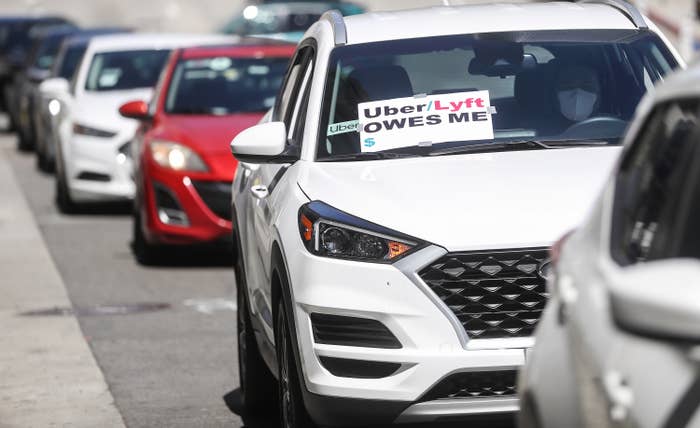
Uber and Lyft drivers protest in California
Labor leaders have not always agreed on the best strategy for fighting the gig economy’s encroachment.
In June 2019, the New York Times reported that even when victory seemed at hand, some union bosses had been meeting in secret with industry representatives to talk about negotiating a deal with the companies rather than continuing to fight them in the courts and the statehouse. The move created “deep rancor” within the labor movement, according to the Times.
While cutting a deal with Uber and Lyft would inevitably have forced unions to make concessions, it might also have spared them the considerable expense of fighting the companies. As venture-backed technology firms, the gig companies have access to unprecedented amounts of cash. Their investors aren’t worried about them spending hundreds of millions of dollars to beat back regulation, because none of the companies are profitable anyway. Gig economy backers are happy to spend as much as it takes for the companies to find a way forward for the independent contractor model — because if they can’t, the whole experiment might as well be over anyway. By claiming the crisis is existential, gig companies can justify any amount of spending to resolve it.
Though unions have long fought well-capitalized corporations, tech’s particularly reckless kind of spending is impossible for them to compete with. “They spent $20 million in the last week [of the campaign] alone, which is more than veteran consultants here in California have ever seen by a lot,” said Steve Smith, communications director for the California Labor Federation, who worked closely with the campaign against 22.
Bradley Tusk, a political consultant who helped Uber in some of its earliest regulatory battles, said the labor movement got a leg up with AB5 because Uber overcorrected on its bad reputation under former CEO Travis Kalanick and got too soft.
“You can’t be loved by everyone or avoid criticism by everyone and at the same time win this kind of thing,” Tusk said. “[Uber] didn’t spend enough money. Everything that it would take — the messaging, the messengers, the resources — wasn’t there, and they lost,” he continued. Uber wouldn’t make that mistake again. “They realized it was a potentially existential crisis for them, they spent $200 million to fix it, and they did.”
Even as the tech companies spent that record sum, the financial resources that the labor movement had to fight back with were spread unusually thin. Prop 22 wasn’t even the movement’s top priority; another ballot initiative aimed at getting corporations to pay property taxes, Prop 15, had been a major focus of the labor movement for almost a decade. Had it passed, the measure would have brought a huge influx of cash into the state budget, a boon for public sector unions. Other statewide ballot initiatives that required unions’ attention and funds this election cycle included a proposition to eliminate cash bail and another to regulate dialysis clinics.
“Usually when we have a ballot campaign, there’s one that everybody just focuses on, and we can raise money from labor and outside sources all sort of focused on that campaign,” said Smith of the California Labor Federation. “This year, we had a number of them that were really important.”
On top of that, some individual donors who might have supported the fight against Prop 22 chose instead to focus on national politics, hoping to win Democratic seats in the Senate and unseat President Donald Trump. And it didn’t help matters that major Democratic leaders in the state — including Gov. Gavin Newsom, who might have directed dollars to labor — stayed out of the ballot fight.
Gonzalez said, “There were a lot of different priorities.”
As a result, there just wasn’t as much cash to go around as there might have been. All in all, the anti–Prop 22 campaign spent around $20 million — about 10 times less than the companies spent to pass it.
Most experts agree that given the sheer amount of money the tech industry was willing to spend, there wasn’t much the campaign against Prop 22 could have done differently.
“When you’re facing that kind of opposition spending, it’s very difficult to get your message across,” Smith said. “We did the best job we could given the limited resources we have.”
Ballot measures can be complicated and boring, and sometimes don’t fall neatly on one side of the partisan divide or the other. This tends to give whichever side has the deeper pockets an even greater advantage when it comes to defining the narrative in a campaign.
The “Yes on Prop 22” campaign spent its money saturating airwaves and inundating mailboxes with campaign materials that claimed the measure would actually protect workers and their jobs. It was a clever argument, considering it was the companies themselves who were threatening to raise prices and cut the number of available gigs if they didn’t get their way. Ads in favor of Prop 22 mentioned a fund for healthcare and guaranteed minimum earnings. Although one labor-backed study found that the deal wouldn’t actually guarantee more than $5.64 an hour, it nonetheless succeeded in confusing some voters into thinking a “yes” vote was in support of workers’ rights. That made it difficult for the unions to explain, even to liberal voters, why they should vote against it.
For its part, the Yes campaign said voters knew exactly what they were doing. “Nine million Californians voted yes on Prop 22,” spokesperson Geoff Vetter told the Washington Post. “To suggest that these millions were somehow so feebleminded they voted for something they didn’t want is offensive to voters and flat out wrong.” Uber spokesperson Noah Edwardsen said: “A diverse and sizable majority of California voters, from both parties and nearly all corners of the state, said Yes on Prop 22. That’s simply a fact.”
The worker-friendly veneer of the tech companies’ messaging was so successful that some early focus groups conducted by unions found that voters who had read the proposition’s language assumed it was actually written and funded by the labor movement, according to Smith.
“We had as many people saying unions were behind it as saying the companies were behind it,” he said. “That was their strategy — confuse this thing every day for a year and make sure voters don’t really know what’s going on.”
Unions are, of course, accustomed to being outspent by their corporate opponents. But the tactics they typically rely on to combat that imbalance — like organizing at workplaces and door-knocking with volunteers — were disrupted by the pandemic. That was compounded by the mounting frenzy of the presidential election, as the behavior of President Trump, an expert at dominating media attention, grew increasingly erratic.
The combination of all those factors made it increasingly difficult for the labor movement to regain control of the narrative. “There was just no way of getting our voice across,” Gonzalez said.
The fact that corporations in California can choose to sidestep the law if they’re willing to spend aggressively enough to do it strikes some as unfair. The ballot initiative process was intended to make the legal system more democratic by allowing the people to have a voice. But corporate spending in electoral politics has warped the proposition system, allowing companies to manipulate it — not just by buying ads but by paying for the signatures that get the measures on the ballot to begin with.
Nelson Lichtenstein, a labor history professor at the University of California, Santa Barbara, said efforts to reform the process have gained little traction. In 2018, then–California governor Jerry Brown actually vetoed a bill that would have made paying for signatures to get a measure on the ballot illegal.
“The propositions have become a mechanism for wealthy people or institutions,” Lichtenstein said. “Everyone is denouncing Uber and Lyft for spending $200 million on this, but I’ve seen no proposal to say that we should somehow regulate this to not be able to do that.”
For Uber, that was money well spent. “The day after they won the referendum, their stock price went up,” Lichtenstein said. “It was an extremely effective investment.”
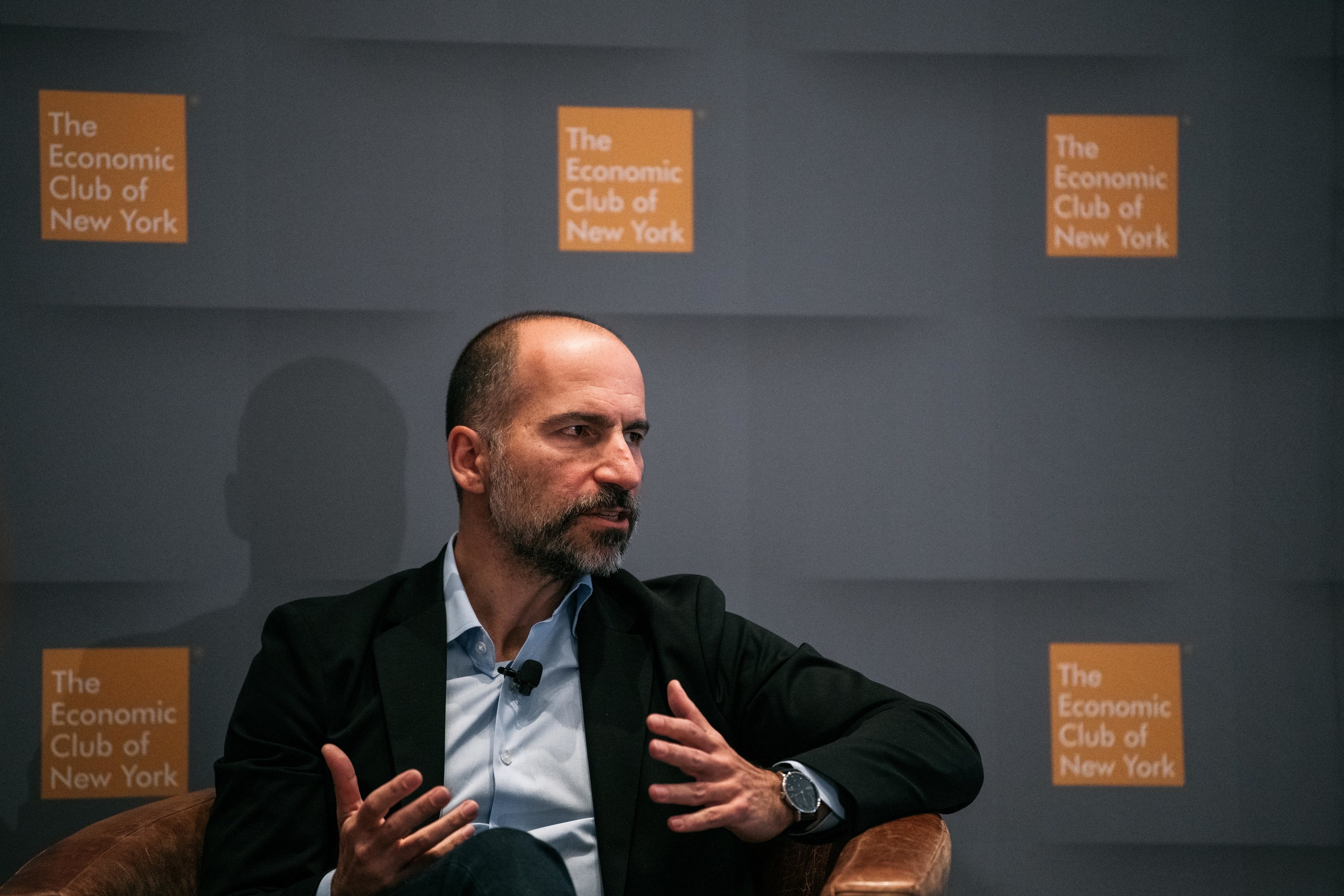
Uber CEO Dara Khosrowshahi
That’s good news for Uber CEO Dara Khosrowshahi, who earns a salary of around $1 million, received a $40 million stock grant in 2019, and has spent millions more acquiring additional Uber stock. After the election, Khosrowshahi said the company plans to “loudly” advocate for laws similar to Prop 22 in other states.
The law is all but permanent in California, where the language of the proposition requires a seven-eighths supermajority for it to be overturned. That leaves gig workers in California without unemployment insurance or paid sick leave as they continue to work through the ongoing global pandemic. The majority of those workers are people of color, who are more likely to experience serious health effects from the coronavirus but less likely to benefit from any economic recovery.
As low-wage earners have struggled to recover from this year’s unprecedented economic fallout, delivery apps meant to provide a side hustle are, for some people, now the only opportunity to earn any income at all. If laws like Prop 22 are passed in other states, it will cement gig work as something that’s more about getting through desperate times than about finding a path to stability and security.
Some leaders within the labor movement are hopeful that President-elect Joe Biden will make gig workers’ rights part of his agenda when he takes office in January. But given the close ties between Biden and the many former Obama administration officials who took jobs in the tech industry, that seems unlikely. Lyft’s policy chief, Anthony Foxx, served as Obama’s transportation secretary when Biden was vice president. Vice President-elect Kamala Harris is sister-in-law to Tony West, who has been Uber’s top lawyer since 2017. And recently, Biden named former deputy labor secretary Seth Harris to his labor transition team — Harris coauthored a paper in 2015 that proposed the creation of a third worker classification, a permanent legal workaround to making gig workers employees.
Bradley Tusk, the political consultant, put it bluntly: “I don’t think this is something the Biden administration will spend a lot of time on,” he said. “If they’d won the Senate, that’s one thing. But without it, he’s going to have enough trouble getting stimulus passed or infrastructure.”
But even given that, Tusk doesn’t think the gig economy’s battle with workers is over just yet. There are pending bills in states, including New York, New Jersey, and Illinois, that the gig companies will have to fight.
“By winning Prop 22, they slowed momentum around the country,” he said, “but the issue isn’t going away.”


